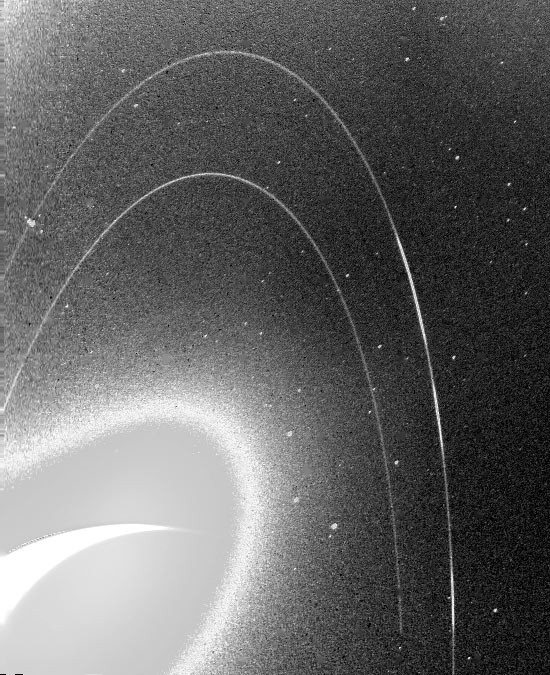
Did you know that Neptune has rings?
It’s true. The planet we’re now told is the farthest from us has a set of narrow bands made of dust. Planetary scientists know this, as do hard-core astronomy fans, probably. But for those of us who have certain textbook images of the solar system in our mind, the knowledge that Neptune is a ringed planet might come as a surprise. So I wanted to present this information to you, and let it sink in a little bit, before getting into the news of the day: Astronomers have directed their best space telescope at Neptune and captured the clearest view of its rings in more than 30 years.
There they are, a pair of delicate bands encircling a shimmery marble, the whole ensemble doing its best impression of Saturn. The observatory that produced the image, the James Webb Space Telescope, works in infrared wavelengths, so Neptune resembles a spooky crystal ball dipped in dry ice rather than its usual, striking cobalt-blue self. This was part of the promise of the Webb mission: As the telescope searched the depths of the universe for the faintest, earliest galaxies, it would also provide an entirely new view of our cosmic neighborhood. And already, that promise is being fulfilled. We’ve never seen Neptune and its rings like this before.
Scientists imagined that Neptune might have rings well before they had any evidence. After all, Saturn had them, and so, it turned out, did Uranus and Jupiter. (I know, right? Those classic illustrations of the solar system really left a lot out.) Astronomers discovered faint bands around Uranus using ground-based observations in 1977, and NASA’s Voyager mission revealed the same around Jupiter in 1979. The evidence for Neptune’s rings came in 1989, when Voyager finally reached that planet and revealed wispy, elegant arcs.
[Read: A gnarly new theory about Saturn’s rings]

That 33-year-old image was our best view of Neptune’s ring system until now. No spacecraft has visited the planet since Voyager, and space telescopes such as Hubble have already observed the planet about as much as they can. The Webb telescope is far more powerful than Hubble and has not only captured the sharp outlines of the planet’s rings, but resolved the fuzzy bands of dust that hover between them. Those iridescent bright spots on the planet itself? They are clouds made of methane ice. The tiny specks of light around the planet are moons—seven of them. Zoom out further, and you’ll see a bluish jewel; that is Triton, Neptune’s largest moon. Triton, a world covered in frozen nitrogen, is so reflective that it resembles a star, in Webb’s view. The Voyager mission detected plumes of nitrogen gas coming from cracks in the frosty surface, and astronomers think that Triton has a subsurface ocean—making the moon an intriguing candidate in the search for microbial alien life.

Triton, resembling a shiny, bluish jewel, with its parent planet (NASA, ESA, CSA, and STScI)
The new Neptune observations are the first of many for the Webb telescope, which has been making the rounds of the solar system since it began operations this summer. The observatory has captured a remarkable view of Jupiter and the lustrous auroras drifting over its poles, and snuck a peek at Mars. Uranus will eventually get its own close-up too. (There will be no Webb views of Venus and Mercury, though; Webb’s mirrors are oriented toward deep space and away from the sun, Earth, and other objects in the inner solar system—all bright sources that would fry the observatory’s instruments.)
[Read: We don’t know Neptune at all]
The first direct observations of Neptune were made in 1846. Astronomers already suspected that the planet existed; they had noticed, more than half a century earlier, some irregularities in Uranus’s orbit that could only be explained by the presence of another celestial body further out. In their telescopes, Neptune was a tiny speck of light, as ordinary as any other star in the night sky. We are much more familiar with Neptune now, although the planet still has its mysteries. Scientists don’t know why Neptune radiates more heat than it absorbs from the sun, whereas Uranus, which is similar in composition and orbits closer in, doesn’t. Nor do they understand the peculiar nature of Neptunian weather and seasons. But those mysteries can wait, at least for a little bit, when you’ve got pictures like these. Heidi Hammel, an astronomer at the Association of Universities for Research in Astronomy who studies the planet, tweeted this morning that she cried when she saw Webb’s images of Neptune: “I was yelling, making my kids, my mom, even my cats look.” Presumably the cats didn’t know Neptune had rings, either.







